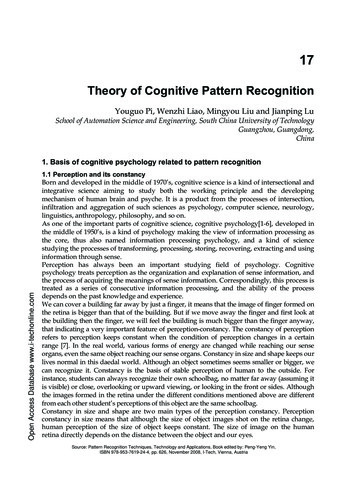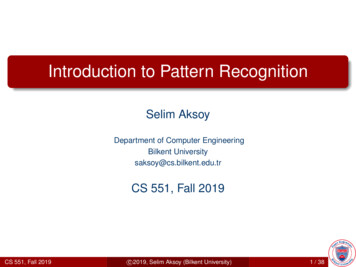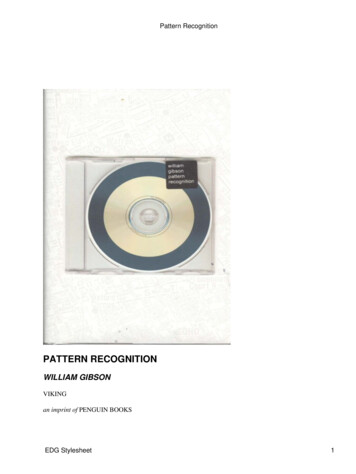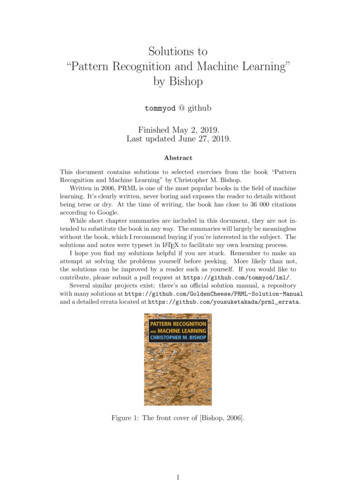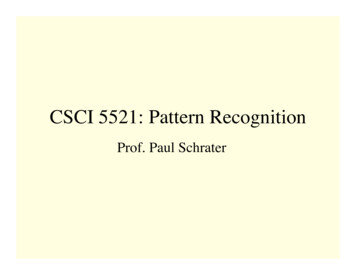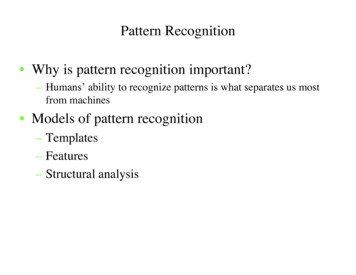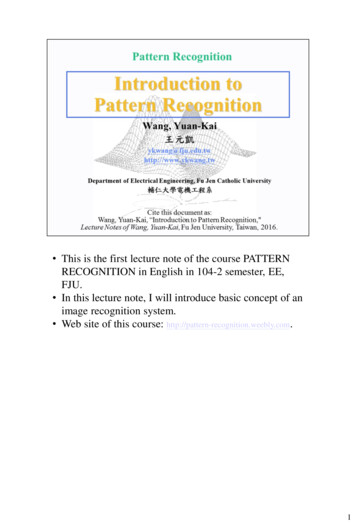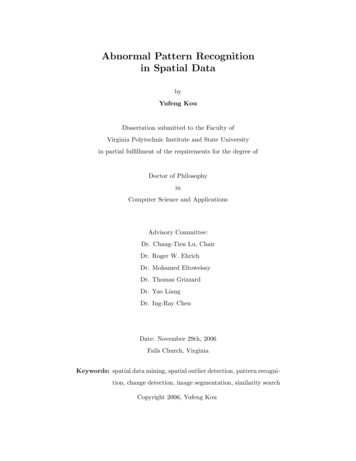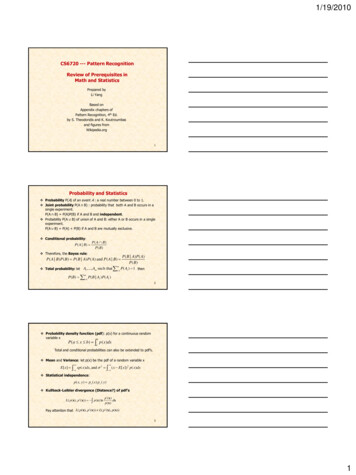
Transcription
Pattern Recognition
Course: CSE 352Professor: Anita WasilewskaTeam 16:Soham GujralMubinar AlamJanmejay BhavsarSharyar Khan
er.com/chapter/10.1007/978-3-319-23117-4 ://arxiv.org/pdf/1605.01156.pdf
OutlineOverview of Pattern RecognitionWhat is Pattern Recognition?Where do we use Pattern Recognition?How are Patterns Discovered?What are some approaches to patternRecognition?Applications of Pattern Recognition.
TheTurk
Motivation toexplorepatterns:Once IBM could build machines that couldrecognize as many chessboard patterns as achess grandmaster, the machines became"smarter" than humans.4Medical diagnostics can be more accurateand cheaper.1Economics can be studied with patternrecognition and more concrete predictions canbe made. 2Wildlife and climate preservation can bemuch more successful with advent of patternrecognition based research.3Pattern recognition can inevitably improve /revolutionize almost all fields that we careabout today.
What is a Pattern?A pattern is an entity, vaguelydefined, that could be given a name,e.g. fingerprint image, handwrittenword, human face, speech signal,DNA sequence.
What is PatternRecognition?Pattern recognition involves finding thesimilarities or patterns among small,decomposed problems that can help ussolve more complex problems.
Pattern Recognition versus AIThe most significant difference between AI and Pattern Recognition is that AIfocuses on the reasoning part and Pattern Recognition on the observations derivedfrom any data.AI emphasizes primarily the modelling of human knowledge and reasoning and thenit may adapt these models to observations whereas Pattern Recognition does notdirectly mimic knowledge and reasoning, but the handling of observations as theyare given and then the observations have to be generalized and to be integratedwith available knowledge.
Pattern Recognition and AIThe term artificial intelligence is applied when a machine mimics cognitivefunctions that humans associate with other human minds, such aslearning and problem solvingPattern Recognition is a subfield of AI and thus focuses on the recognitionof patterns and regularities in data
Who is using it?Google (Google Analytics, Voice Search,Reverse Image Search)Ada Health (The Amazon Alexa ofHealthcare)Amazon (Suggested Items)Soundcloud (Music Discovery)
Pattern RecognitionProcessA generic process of pattern recognition:1. Data Acquisition and Collection2. Feature extraction andRepresentation3. Similarity Detection and PatternClassifier Design4. Performance Evaluation
Classifications ofPattern RecognitionHow Do We Do It?Two methods of classifications havebeen developed: Supervised andUnsupervised learning.Supervised Learning: Set of trainingdata has to be provided and labeled withthe correct outputUnsupervised Learning: training data isnot labeled or there is no training data
SupervisedClassification-Supervised pattern recognition createsclassifiers using supervised learningalgorithms to create classifiers fromvarious object classes.-Classifiers that are freshly created thenaccept input data and create new objectsas well as class labels.-These techniques are used in computervision for many things including facedetection/recognition, object detection, andoptical recognition.
Supervised Classification (cont)
Unsupervised classification finds hiddenfeatures in unlabeled data using clusteringor data segmentation techniques.Unsupervised ClassificationGaussian Mixture Models, Hidden MarkovModel, and K- clustering.Example of K-clustering
How are Patterns Discovered?Patterns can be found by identifyingsimilarities between objects that arethe same or very close to eachother. Sometimes not properties arefound we is also a useful result
Some Techniques:What are someapproaches topatternRecognition?Template Matching: Quality ControlStatistical Pattern Recognition:Recognition of shipsArtificial Neural Networks:Stock Market PredictionSyntactic pattern recognition:Syntactic pattern recognition
Applications of PatternRecognition
Climate change andpattern recognitionContemporary climate archives are approximately 5PB (1000 terabytes) in size6.Being, perhaps, one of the most important topics of 21st century, scientists areusing several mechanisms to make sense of the patterns of climate change.Big data and climate inst-climate-changeDetection of extreme climate events using neural networks and patterns:https://arxiv.org/pdf/1605.01156.pdf
Deep Convolutional NeuralNetworkProblem:There is no universally accepted sets of criteria for what defines a tropical cyclone. The ”Low” Pressure and ”Warm” Temperature are interpreted differently amongclimate scientists, therefore different thresholds are used to characterize them.Solution:Formulate the problem of detecting extreme climate events as classic visual pattern recognition problem.89% to 99% accuracy in detectingextreme events. 11
Biometrics and Pattern Recognition1. Biometrics refers to the automatic recognition of an individual by usinganatomical or behavioral traits associated with that person by using theconcept of pattern recognition techniques.2. Biometric Technology is used in fingerprint scanners, facial recognitionsystems, voice recognition systems, etc.
Bioinformatics andPattern Recognition1. Bioinformatics deals with developmentof algorithms and software forunderstanding the biological data10.2. A particular field of bioinformatics usesthe application of pattern recognitionfor protein classification : A goodprotein classification system must takeinto account the following elementsnamely, structure, sequence,biomolecular interaction andsubcellular localization 9.
Criminology and Pattern Recognition1. The field of computational criminology involves using the pattern recognitiontechnique to identify patterns and emerging patterns, crime generators andcrime attractors, terrorism, organized crime and gang social and spatialnetworks as well as co-offending networks and cyber crime 8.2. The most significant advantage of using Pattern Recognition in Criminology isthat crime and terrorism are not random and thus follow a specific pattern orMO(modus operandi). Thus we can find criminals in huge populations.
Criminology and Pattern Recognition“Stealth Wear Aims to Make a TechFashion Statement” - The NewYork Times
Take homeWhy AI still stinks at pattern cognitionMicrosoft Researches Use Pattern Recognition to Generate a Rembrandt Paintinghttps://www.nextrembrandt.com
Pattern Recognition versus AI The most significant difference between AI and Pattern Recognition is that AI focuses on the reasoning part and Pattern Recognition on the observations derived from any data. AI emphasizes primaril

